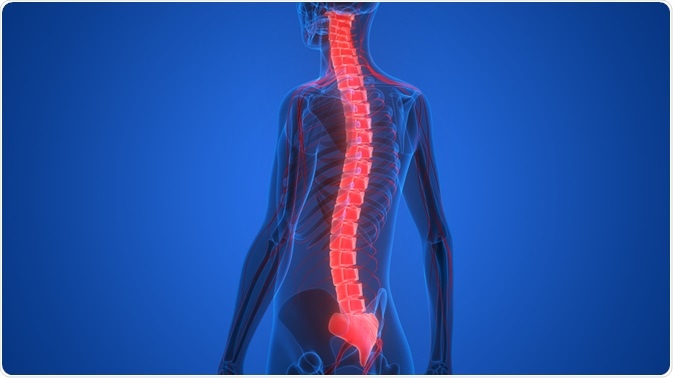Nanoparticles are small particles that can be used to deliver drugs to otherwise unreachable areas. The spinal cord, part of the central nervous system, can be difficult to treat, has been a focus of nanoparticle treatment.

Image Credit: Magicmine/Shutterstock.com
Why and how nanoparticles work
Nanoparticles have been investigated for potential use in inflammation and injury treatment during the past decade. The key benefit that sets nanoparticles apart from previous treatments is the more localized effect that is possible, as compared with systemic injections or generalized treatments.
While nanoparticles can target specific sites, their administration can be more general, such as via intravenous injection. This can allow for sustained treatment of injuries using drugs that might otherwise have toxic effects limiting their use.
Furthermore, certain encapsulation methods allow for the sequential release of drugs over time, thereby limiting the number of injections needed.
Transporting drugs to the injury site
Injury to the spinal cord can result in paralysis, dangerous infections, and death. Injuries can be difficult to treat, as there is an inflammatory response to damage and existing medication can have serious side effects that are likely associated with the drugs’ toxicity to other organs.
Nanoparticles can assist in overcoming such obstacles by delivering the drugs to the injury site directly, rather than the drugs being injected systemically. For example, methylprednisolone, a synthetic glucocorticoid, can minimize the neurological deficits following spinal cord injury, but can also cause gastric bleeding, sepsis, pneumonia, and wound infection.
Nanoparticles have been tested to deliver methylprednisolone directly to injured spinal cords, increasing the drug’s efficacy and decreasing negative effects. Furthermore, nanoparticle delivery allows for the use of a lower dose, at around 1/20th of the systematically administered dose.
One of the main traumatizing effects of spinal cord injury is the leakage of blood and fluid into the spinal cord space, which creates a type of cyst. This can be stopped by minimizing blood flow in compromised blood vessels, which can be done with fibroblast growth factor 2 (FGF2).
FGF2 can usually not be administered systemically because FGF2 is not capable of crossing the blood-spinal cord barrier. FGF2 has been successfully encapsulated in hydrogel PLGA nanoparticles and delivered to spinal cord injury sites in rats and resulted in improved blood vessel density after injury.
Affecting the immune system
In addition to delivering drugs, nanoparticles can be used to affect the immune system by moving immune cells around the body. It is believed that PLG-based nanoparticles with a negative zeta potential bind to circulating immune cells, altering their traffic towards the spleen, and thereby indirectly reduce the immune response to the inflamed area of the spinal cord and create a therapeutic benefit.
New research has focused on how immune cells can be reprogrammed to enhance the immune response to the damaged spinal cord, and thereby improve regeneration. Nanoparticles have been shown to enter immune cells and regulate their biodistribution, gene expression, and function.
This, in turn, has been shown to lead to increased accumulation of nanoparticle-positive immune cells at the site of spinal cord injury, coupled with the reduction of innate immune cells and gene expression of pro-inflammatory factors and increase of anti-inflammatory and pro-regenerative gene expression.
This shows that nanoparticles can affect the microenvironment and alter cellular phenotypes. The effect on gene expression, which drives the changes in phenotype and microenvironment, can be both short term and long term.
For example, when nanoparticles have been injected to upregulate anti-inflammatory factors, these changes are sustained in the long term and thereby further promote locomotor recovery.
Sources
Park, J. et al. (2019). Intravascular innate immune cells reprogrammed via intravenous nanoparticles to promote functional recovery after spinal cord injury. Proceedings of the National Academy of Sciences of the United States of America. https://doi.org/10.1073/pnas.1820276116
Kim, Y.T. et al. (2009). Nanoparticle-mediated local delivery of methylprednisolone after spinal cord injury. Biomaterials. https://doi.org/10.1016/j.biomaterials.2008.12.077
Kang, C.E. et al. (2013). Localized and sustained delivery of fibroblast growth factor 2 from a nanoparticle hydrogel composite for treatment of spinal cord injury. Cells Tissues Organs. https://doi.org/10.1159/000339589
Further Reading
Last Updated: Jan 23, 2020